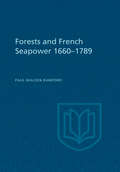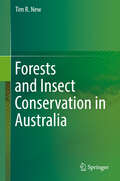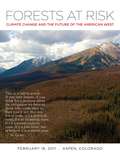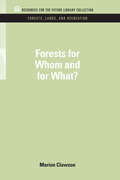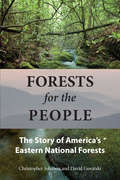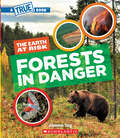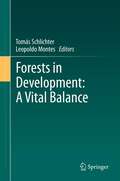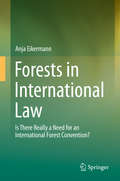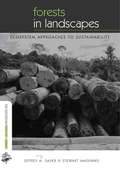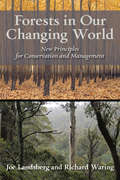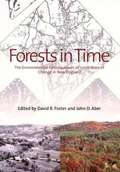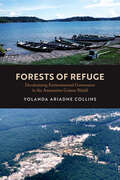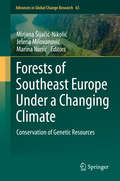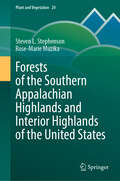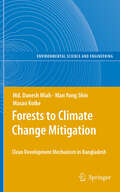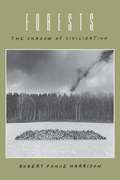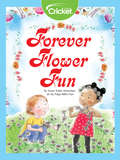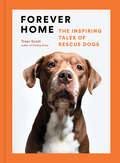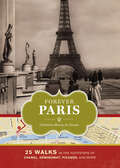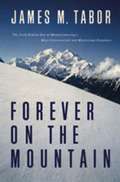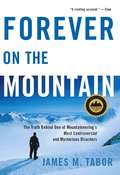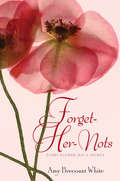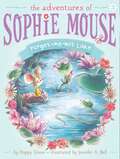- Table View
- List View
Forests and French Sea Power, 1660-1789
by Paul Walden BamfordBy choosing to concentrate upon discovering what forest resources were available to the French navy during the ancien régime and what use it was able to make of them, Mr. Bamford has not only provided the first monograph on that subject in the English language, but has gone far toward explaining why France was the loser in the long duel with England for the control of commerce and the extension of empire. <P><P> Two years of research in the Archives Nationales and in the Archives de la Marine in Paris, Toulon, and Rochefort enabled him to draw on contemporary sources of information of which little, if any, use has been made before, and a further year of research in the libraries of New York City, particularly in the rich Proudfit Naval Collection, also yielded new material. It is Mr. Bamford's achievement to have handled this vast store of primary sources with such skill and judgement that the reader, by turning over letters from disgruntled forest proprietors, reports from harassed maîtres on the trickery and recalcitrance of the peasants, instructions from the top echelon of the navy to inspectors in the forests, and a variety bills, receipts, and memoranda, is given at first hand an appreciation of the difficulties faced by the navy in trying to obtain timber and masts of the choice quality required for building ships-of-the-line. The navy had to compete with the merchant marine and with industrial and private users of fuel for supplies that were continually being depleted by mismanagement and by the conversion of forests to arable land. Measures, superficially admirable, for conserving the forests are found on closer examination to be at once over-precise and not properly enforced. Transport, even in a country so abundantly supplied with navigable rivers as France, was expensive and difficult.<P>Not only historians, but scholars in the field of forestry, economics, geography, agriculture, and transport will find this book illuminating.
Forests and Global Change
by David A. Coomes David F. R. P. Burslem William D. Simonson David A. Coomes David F. R. P. Burslem William D. SimonsonForests hold a significant proportion of global biodiversity and terrestrial carbon stocks and are at the forefront of human-induced global change. The dynamics and distribution of forest vegetation determines the habitat for other organisms, and regulates the delivery of ecosystem services, including carbon storage. Presenting recent research across temperate and tropical ecosystems, this volume synthesises the numerous ways that forests are responding to global change and includes perspectives on: • the role of forests in the global carbon and energy budgets • historical patterns of forest change and diversification • contemporary mechanisms of community assembly and implications of underlying drivers of global change • the ways in which forests supply ecosystem services that support human lives. The chapters represent case studies drawn from the authors' expertise, highlighting exciting new research and providing information that will be valuable to academics, students, researchers and practitioners with an interest in this field.
Forests and Insect Conservation in Australia
by Tim R. NewLosses of forests and their insect inhabitants are a major global conservation concern, spanning tropical and temperate forest regions throughout the world. This broad overview of Australian forest insect conservation draws on studies from many places to demonstrate the diversity and vulnerability of forest insects and how their conservation may be pursued through combinations of increased understanding, forest protection and silvicultural management in both natural and plantation forests. The relatively recent history of severe human disturbance to Australian forests ensures that reasonably natural forest patches remain and serve as ‘models’ for many forest categories. They are also refuges for many forest biota extirpated from the wider landscapes as forests are lost, and merit strenuous protection from further changes, and wider efforts to promote connectivity between otherwise isolated remnant patches. In parallel, the recent attention to improving forest insect conservation in harmony with insect pest management continues to benefit from perspectives generated from better-documented faunas elsewhere. Lessons from the northern hemisphere, in particular, have led to revelations of the ecological importance and vulnerability of many insect taxa in forests, together with clear evidence that ‘conservation can work’ in concert with wider forest uses. A brief outline of the variety of Australian tropical and temperate forests and woodlands, and of the multitude of endemic and, often, highly localised insects that depend on them highlights needs for conservation (both of single focal species and wider forest-dependent radiations and assemblages). The ways in which insects contribute to sustained ecological integrity of these complex ecosystems provide numerous opportunities for practical conservation.
Forests at Risk: Climate Change and the Future of the American West
by Aspen Center for Environmental StudiesClimate change poses a huge threat to the West. The currmountain pine beetle epidemic with over 50 million acres of dying trees in western North America has created a powerful “teachable moment” across the region. A primary goal of the Forests At Risk symposium was to reframe the nation’s climate change dialogue by making the issue both personal and real to many who may not appreciate its connection to the immediate world around them. While some may have difficulty relating to rising sea levels, falling water tables, imperiled polar bears and melting glaciers in far-off places, they are still shocked by the sight of vast dying forests around their homes. The Forests At Risk symposium explored the statemby Andy Jacobson, a carbon cycle scientist at the National Oceanic and Atmospheric Administration in Boulder, that “this is the kind of feedback we're all very worried about in the carbon cycle ... a warming planet leading to, in this case, an insect outbreak that increases carbon dioxide into the atmosphere, which can increase warming.” The overwhelming scientific consensus holds that climate change is one of the mserious threats facing humankind today. We have a soberingly short time in which to reduce atmospheric greenhouse gases if we are to preserve our quality of life and environment. In addition to the global urgency, the American West is deeply dependon the health of its forests, mountains and streams for both its quality of life and its economy. Put simply, if global warming shortens our winters, diminishes our recreation, and unleashes wildfires, diseases and insect epidemics that devastate our forests, the regional damage would be incalculable. NOW is the perfect time to learn more in this ebook. The Forests At Risk symposium represented the first substantial public forum focused directly on the connection between climate change and forest health in the American West. In the wake of millions of acres of pine beetle devastation across our continent, this is the ideal momto highlight the climate change connection and focus on the question of what happens when our forests transform from carbon sinks into carbon sources.
Forests for Whom and for What? (RFF Forests, Lands, and Recreation Set)
by Marion ClawsonClawson is concerned here not so much with what forest policy should be, but more with the criteria by which it should be determined. He lists such questions as how much land to devote to forests, how much timber to harvest and the best means of harvesting it, and the compatibility or incompatibility of forest uses as the issues to be dealt with in formulating forest policy. Originally published in 1975
Forests for the People: The Story of America's Eastern National Forests
by Christopher Johnson David GovatskiAt the turn of the twentieth century, widespread clearcutting resulted in ecological ruin and devastating fires in America's Eastern forests. A coalition of citizens, organizations, and business and political leaders fought against this pattern, and in 1911, they achieved a landmark victory with the Weeks Act, which protected millions of acres of Eastern forests. Forests for the People tells the fascinating story of this vital legislation and the citizens and organizations that made it a reality. While these protected forests survive today, many of the critical issues facing American forests in the twentieth century persist, and new threats have arisen--including oil shale drilling, invasive species, and development around national parks. In Forests for the People, Christopher Johnson and David Govatski draw upon the lessons and victories of the past to examine the vital issues facing American forests today and illuminate paths to better forest management.
Forests in Danger (A True Book (Relaunch))
by Jasmine TingDiscover the rich biodiversity of Earth's biomes - and how they might be saved - with this STEAM-based subset of True Books.Did you know that forests contain many plant and animal species that are still unknown to science? This leafy biome is also a key to slowing climate change! Get ready to investigate Earth's wildly diverse forest ecosystems, as well as the plants and animals that have adapted to survive in them. You'll also learn about the many threats facing this fascinating biome - and what each of us can do to help - all in the pages of Forests in Danger.ABOUT THE SERIES:There are five major biomes on Earth: desert, forest, grassland, aquatic, and tundra. These rich, wild places are home to a wide variety of plants and animals - many of which are found nowhere else. Unfortunately, these ecosystems have been put at risk by human activities. This STEAM-based set of True Books introduces students to the incredible biodiversity of Earth's amazing biomes, as well as the threats they face in the era of climate change. Interesting information is presented in a fun, friendly way - and in the simplest terms possible - and will inspire kids to think about how they can help stop the destruction of Earth's wild spaces.
Forests in Development: A Vital Balance
by Tomás Schlichter Leopoldo MontesForests in Development: A Vital Balance, shows some of the main advances in forestry over the six years spanning between the XII World Forestry Congress in Canada and the XIII WFC held in Buenos Aires. The book covers most of the themes of the XIII WFC, from biodiversity through production, policies, environmental services, and economic aspects, linked by sustainability. It provides a comprehensive view of forestry today, conveying its different aspects through one solid piece addressed by authors whose work denotes a concept of sustainable forest management which is not so much a puzzle laboriously put together as a many-faced unity, steered to achieve ultimately a better quality of living for present and future generations.
Forests in International Law
by Anja EikermannThis book investigates the potential need for an international convention on forests and establishes a multifunctional concept of forests as a cornerstone for international forest regulation. Accordingly, it examines a variety of international instruments pertaining directly or indirectly to forests and explores their entangled, fragmented nature. While contending that the lack of consistency in international law impedes the development of a stand-alone international forest convention, at the same time it argues that the lessons learned from fragmentation as well as from the history of forest discourse on the international level open up new options for the regulation of forests in international law, based on (new) concepts of coordination and cooperation.
Forests in Landscapes: Ecosystem Approaches to Sustainability (The\earthscan Forest Library)
by Jeffrey Sayer�At last a really useful book telling us how all the rhetoric about ecosystem approaches and sustainable forest management is being translated into practical solutions on the ground� CLAUDE MARTIN, WWF INTERNATIONAL �For too long, foresters have seen forests as logs waiting to be turned into something useful. This book demonstrates that forests in fact have multiple values, and managing them as ecosystems will bring more benefits to a greater cross-section of the public� JEFFREY A. MCNEELY, CHIEF SCIENTIST, IUCN �This book demonstrates that [ecosystem approaches and sustainable forest management] are neither alternative methods of forest management nor are they simply complicated ways of saying the same thing. They are both emerging concepts for more integrated and holistic ways of managing forests within larger landscapes in ways that optimize benefits to all stakeholders� ACHIM STEINER AND IAN JOHNSON, FROM THE FOREWORD Recent innovations in Sustainable Forest Management and Ecosystem Approaches are resulting in forests increasingly being managed as part of the broader social-ecological systems in which they exist. Forests in Landscapes reviews changes that have occurred in forest management in recent decades. Case studies from Europe, Canada, the United States, Russia, Australia, the Congo and Central America provide a wealth of international examples of innovative practices. Cross-cutting chapters examine the political ecology and economics of forest management, and review the information needs and the use and misuse of criteria and indicators to achieve broad societal goals for forests. A concluding chapter draws out the key lessons of changes in forest management in recent decades and sets out some thoughts for the future. This book is a must-read for practitioners, researchers and policy makers concerned with forests and land use. It contains lessons for all those concerned with forests as sources of people's livelihoods and as part of rural landscapes. Published with IUCN and PROFOR
Forests in Our Changing World: New Principles for Conservation and Management
by Richard Waring Joe LandsbergScientists tell us that climate change is upon us and the physical world is changing quickly with important implications for biodiversity and human well-being. Forests cover vast regions of the globe and serve as a first line of defense against the worst effects of climate change, but only if we keep them healthy and resilient. Forests in Our Changing Worldtells us how to do that. Authors Joe Landsberg and Richard Waring present an overview of forests around the globe, describing basic precepts of forest ecology and physiology and how forests will change as earth's climate warms. Drawing on years of research and teaching, they discuss the values and uses of both natural and plantation-based forests. In easy-to-understand terms, they describe the ecosystem services forests provide, such as clean water and wildlife habitat, present economic concepts important to the management and policy decisions that affect forests, and introduce the use of growth-and-yield models and remote-sensing technology that provide the data behind those decisions. This book is a useful guide for undergraduates as well as managers, administrators, and policy makers in environmental organizations and government agencies looking for a clear overview of basic forest processes and pragmatic suggestions for protecting the health of forests.
Forests in Time: The Environmental Consequences of 1,000 Years of Change in New England
by John D. Aber David R. FosterThis important book relates the history of natural and human-induced changes that have occurred in the past one thousand years in New England and explores the modern ecology of this largely forested landscape. Written by leading biological, physical, and social scientists, the book uniquely demonstrates that an understanding of landscape history is essential for the study of ecology and environmental management.
Forests of Refuge: Decolonizing Environmental Governance in the Amazonian Guiana Shield
by Dr. Yolanda Ariadne CollinsForests of Refuge questions the effectiveness of market-based policies that govern forests in the interest of mitigating climate change. Yolanda Ariadne Collins interrogates the most ambitious global plan to incentivize people away from deforesting activities: the United Nations–endorsed Reducing Emissions from Deforestation and Forest Degradation (REDD+) initiative. Forests of Refuge explores REDD+ in Guyana and neighboring Suriname, two highly forested countries in the Amazonian Guiana Shield with low deforestation rates. Yet REDD+ implementation there has been fraught with challenges. Adopting a multisited ethnographic approach, Forests of Refuge takes readers into the halls of policymaking, into conservation development organizations, and into forest-dependent communities most affected by environmental policies and exploitative colonial histories. This book situates these challenges in the inattentiveness of global environmental policies to roughly five hundred years of colonial histories that positioned the forests as places of refuge and resistance. It advocates that the fruits of these oppressive histories be reckoned with through processes of decolonization.
Forests of Southeast Europe Under a Changing Climate: Conservation of Genetic Resources (Advances in Global Change Research #65)
by Mirjana Šijačić-Nikolić Jelena Milovanović Marina NonićThis book integrates the different prospective, scientific and practical experience of researchers as well as beneficiaries and stakeholders in the field of forest conservation in Southeast Europe. The book stresses the importance of improving the adaptability of these ecosystems to the impacts of climate change. Gathered around a common idea, the book presents the latest results in forest genetic resources conservation at national and regional level. The chapters are written by experts from: Bosnia and Herzegovina, Bulgaria, Croatia, FYR Macedonia, Greece, Montenegro, Romania, Serbia and Slovenia. The book presents the current state, legal and institutional framework for conservation and management of forest genetic resources, case studies and best practices in the application of different conservation methods and techniques (in situ and ex situ) as well as climate change aspects in this area. This book will be of particular interest to scientists and experts in the field of forestry, environmental protection and rural development, bachelor, master and doctoral students, as well as for anyone interested in the conservation issues fuelled by ethical and economic motives.
Forests of the Southern Appalachian Highlands and Interior Highlands of the United States (Plant and Vegetation #20)
by Steven L. Stephenson Rose-Marie MuzikaSpanning millennia of history and ecological transformation, this book explores the forested and non-forested ecosystems of the Southern Appalachians and Interior Highlands regions of the United States. It examines their fauna and flora, highlighting both shared and regionally distinct species. The volume provides a comprehensive treatment of the terrestrial biota, with chapters devoted to forest composition, vegetation structure, and fungal diversity. Additional chapters focus on the vertebrate and invertebrate fauna of the Appalachians and Ozarks, including mammals, birds, reptiles, amphibians, insects, and non-insect arthropods. Beyond taxonomy and ecology, the authors investigate the historical and contemporary forces that have shaped these landscapes—from the Woodland Period and European colonization to industrial exploitation and modern conservation efforts. Particular attention is given to the ecological impacts of logging, mining, invasive pathogens, and climate change, as well as to the resilience and vulnerability of these ecosystems. Rich in detail and imagery, and grounded in scientific rigor, this volume is an essential resource for ecologists, conservation biologists, forest managers, and anyone seeking a deeper understanding of the ecological heritage and future of these two mountain regions.
Forests to Climate Change Mitigation
by Man Yong Shin Masao Koike Md. Danesh MiahToday, the effect of global climate change is clear to all. It is clearly dangerous in developing countries such as Bangladesh. The industrial revolution caused major changes in technology, socio-economy and cultures in the late 18th and early 19th century, beginning in Britain and spreading throughout the world. The technology dominated economy was mostly dependent on energy produced from fossil fuel, which still holds true today. It is well known that fossil fuel burning has increased the GHGs to the atmosphere, thus creating global warming. Among the GHGs, the concentration of CO2 has been confirmed as the largest. Terrestrial ecosystems are clearly influencing the concentration of GHGs in the atmosphere. Greenhouse gases are constantly entering and leaving the atmosphere. Actively growing trees and other plants absorb CO2 from the atmosphere, combine it with water through photosynthesis and create sugars and more stable carbohydrates. Through this process, trees capture and store atmospheric CO2 in vegetation, soils and biomass products. The Kyoto Protocol, in 1997, explored a flexible mechanism, CDM (Clean Development Mechanism) where Annex I and non-Annex I parties interact for climate change mitigation. Forestry activities have been considered important in the arena of climate change as they act both as a sink and sources of carbon. The purpose of this book is to highlight the means of efficiently reducing global warming through forestry options in Bangladesh and the positive implications of CDM.
Forests: The Shadow of Civilization
by Robert Pogue HarrisonIn this wide-ranging exploration of the role of forests in Western thought, Robert Pogue Harrison enriches our understanding not only of the forest's place in the cultural imagination of the West, but also of the ecological dilemmas that now confront us so urgently.
Forests: The Shadow of Civilization
by Robert Pogue HarrisonIn this wide-ranging exploration of the role of forests in Western thought, Robert Pogue Harrison enriches our understanding not only of the forest's place in the cultural imagination of the West, but also of the ecological dilemmas that now confront us so urgently. Consistently insightful and beautifully written, this work is especially compelling at a time when the forest, as a source of wonder, respect, and meaning, disappears daily from the earth. "Forests is one of the most remarkable essays on the human place in nature I have ever read, and belongs on the small shelf that includes Raymond Williams' masterpiece, The Country and the City. Elegantly conceived, beautifully written, and powerfully argued, [Forests] is a model of scholarship at its passionate best. No one who cares about cultural history, about the human place in nature, or about the future of our earthly home, should miss it.—William Cronon, Yale Review "Forests is, among other things, a work of scholarship, and one of immense value . . . one that we have needed. It can be read and reread, added to and commented on for some time to come."—John Haines, The New York Times Book Review
Forever Flower Fun
by Susan Yoder AckermanThere are so many fun things to do outside during the summer! When the flowers bloom, there is flower fun for everyone! When their hollyhock ladies and daisy chains wilt, Lily Rose and her friend learn how to preserve flowers by drying them. There's always an adventure in nature!
Forever Home: The Inspiring Tales of Rescue Dogs
by Traer ScottThe perfect gift for dog lovers, Forever Home will leave a pawprint on your heart with its series of full-color, close-up portraits of rescue dogs and their stories of adoption, from the photographer of Shelter Dogs and Finding Home.Behind every dog in Forever Home is a touching tale of resilience and love. Packed with twenty-seven heartwarming and inspirational stories of rescue dogs of all ages, this photographic series showcases how the journey to forever isn't always a straight line.Through their portraits and accompanying stories you will fall in love with the adorable canines who have traveled this path, learn of the steps along the way, and celebrate pet rescue and adoption in all its forms. Whether you're a new puppy parent or simply an animal lover, Forever Home is the ideal tribute to our favorite furry friends.
Forever Paris: 25 Walks in the Footsteps of Chanel, Hemingway, Picasso, and More
by Christine Henry de TessanWalking tours inspired by famous figures of France, from artists to chefs to historic leaders.Take a stroll through Édith Piaf’s Belleville, dine at Napoléon’s favorite restaurant, and explore the late-night haunts of Ernest Hemingway, Josephine Baker, and Pablo Picasso. From the author of the best-selling City Walks: Paris, this lively collection of walking adventures follows in the footsteps of more than twenty-five of the city’s iconic former residents. Throughout, Paris is seen from the intimate vantage point of those who loved it best, from the bars where authors penned classic works to the markets and patisseries where food lovers indulged. Including photos and full-color maps throughout, each walk in this book guides visitors and locals through the city that inspired some of the world’s most famous artists, writers, chefs, musicians, politicians, and more.
Forever on the Mountain: The Truth Behind One of Mountaineering's Most Controversial and Mysterious Disasters
by James M. TaborThis book begins as a classic tale of men against nature, gambling--and losing--on one of the world's starkest and stormiest peaks. James M. Tabor draws on previously untapped sources: personal interviews with survivors and those involved in the aftermath, unpublished diaries and letters, and government documents to present a full account of the tragedy that ended a golden age in mountaineering.
Forever on the Mountain: The Truth Behind One of Mountaineering's Most Controversial and Mysterious Disasters
by James M. TaborWinner of the 2007 Banff Mountain Festival Book Awards Grand Prize (The Phyllis & Don Munday Award): "A riveting account of a long-ago mountaineering disaster."--Time In 1967, seven young men, members of a twelve-man expedition led by twenty-four-year-old Joe Wilcox, were stranded on Alaska's Mount McKinley in a vicious arctic storm. All seven perished on what remains the most tragic expedition in American climbing history. Revisiting the event in the tradition of Norman Maclean's Young Men and Fire, James M. Tabor uncovers elements of controversy, finger-pointing, and cover-up that combine to make this disaster unlike any other.
Forget-Her-Nots
by Amy Brecount WhiteSomething-some power-is blooming inside Laurel. She can use flowers to do things. Like bringing back lost memories. Or helping her friends ace tests. Or making people fall in love. Laurel suspects her newfound ability has something to do with an ancient family secret, one that her mother meant to share with Laurel when the time was right. But then time ran out. Clues and signs and secret messages seem to be all around Laurel at Avondale School, where her mother had also boarded as a student. Can Laurel piece everything together quickly enough to control her power, which is growing more potent every day? Or will she set the stage for the most lovestruck, infamous prom in the history of the school?
Forget-Me-Not Lake (The Adventures of Sophie Mouse #3)
by Poppy GreenSophie Mouse wishes she could play in the water at Forget-Me-Not Lake with her friends, but she can’t because she’s a mouse. Or can she? Find out in this third book of The Adventures of Sophie Mouse.Sophie Mouse likes being a mouse. So she’s excited that she and her classmates are making presentations for school about life as the type of animal they are. Sophie has already made a list of things she can do—run fast, scurry into small places, and more. But while playing at Forget-Me-Not Lake with her friends Hattie Frog and Owen Snake, Sophie realizes one thing she definitely can’t do: swim!Hattie and Owen are having so much fun in the water, and Sophie will never be able to join them. Sophie starts to think that being a mouse isn’t so special, after all. When Sophie’s friends notice her disappointment, can they figure out a way to get her out on the water?With easy-to-read language and illustrations on almost every page, the Adventures of Sophie Mouse chapter books are perfect for beginning readers.
